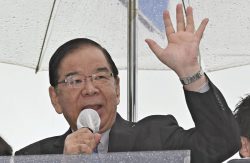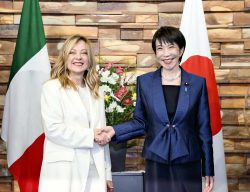15:08 JST, June 13, 2024
If the stability of the European economy is undermined, it will have a major impact on global politics and the economy as well. It is important to steer policies to prevent a resurgence of inflation and ensure a steady economic recovery.
The European Central Bank (ECB) has decided to cut its key policy rates by 0.25 percentage points. This is the first rate cut in four years and nine months. The main key interest rates were lowered from 4.5% to 4.25%.
With the logistical stagnation caused by the COVID-19 pandemic and soaring energy prices due to Russia’s aggression against Ukraine, major developed countries have been affected by high prices, and central banks have responded with rapid rate increases.
This year, Switzerland and Sweden have cut interest rates, and Canada lowered rates this month for the first time in four years and three months. It can be said that the ECB’s rate cut indicates that the fight against inflation has reached a turning point.
The rate of increase in the consumer price index for Germany, France and other eurozone countries peaked at over 10% in October 2022 compared to a year earlier. The ECB has raised interest rates for 10 consecutive meetings since July 2022 to achieve its 2% inflation target and kept them at a high level since October last year.
These efforts have proved effective, and the price increase rate is now firmly at the 2% level.
On the other hand, raising interest rates has the effect of cooling the economy. The eurozone economy has stagnated and it fell into negative growth in the second half of last year. While there are signs of improvement this year, they lack strength. The move to cut interest rates this time is appropriate.
However, it is said that controlling inflation is difficult at the final stage.
ECB President Christine Lagarde said at a press conference that “inflation pressure remains powerful.” The labor market is tight, and it is necessary to remain vigilant against rising service prices, which are linked to wages.
As prolonged high prices have directly impacted the lives of low-income earners, the discontent among citizens is growing. The support fatigue for Ukraine among Western nations has been pointed out, but the sluggish economy is also behind the situation.
In Europe, companies took advantage of the high cost of resources to raise prices beyond the increase in costs, spurring price hikes. This was referred to as “greedflation.”
A resurgence of high prices is also expected. It will be necessary for the ECB to carefully determine the timing of additional interest rate cuts, among other factors.
Meanwhile, this week, the Bank of Japan will decide on its monetary policy for the time being. In contrast to Europe, the focus will be on the path to higher interest rates and revisions to the policy of buying government bonds.
The U.S. economy continues to be strong and the Federal Reserve Board is not expected to cut interest rates this month, so the trend of a weaker yen and stronger dollar is unlikely to change.
It is hoped that the BOJ will scrutinize increasingly complicated overseas developments and make use of those analyses when adjusting its policy.
(From The Yomiuri Shimbun, June 13, 2024)
"Editorial & Columns" POPULAR ARTICLE
-

Artificial Intelligence Expands Possibilities for Foreign Language Learners
-

Build Intellectual, Physical Strength, As Well As Communicative Power / Japan Should Move from Beneficiary to Shaper of World Order
-

Global Economy in Turmoil: Prevent Free Trade System from Going Adrift / Risks to Financial Markets Must Be Heeded
-

Japan-China Strain Set to Persist as Beijing Officials Self-Interestedly Bash Tokyo; Takaichi Unlikely to Back Down
-

Elderly People Living Alone: What Should be Done to Ensure Living with Peace of Mind until the End?
JN ACCESS RANKING
-

Japan Govt Adopts Measures to Curb Mega Solar Power Plant Projects Amid Environmental Concerns
-

Core Inflation in Tokyo Slows in December but Stays above BOJ Target
-

Major Japan Firms’ Average Winter Bonus Tops ¥1 Mil.
-

Bank of Japan Considered U.S. Tariffs, Coming Shunto Wage Hike Talks in Its Decision to Raise Interest Rates
-

Tokyo Zoo Wolf Believed to Have Used Vegetation Growing on Wall to Climb, Escape; Animal Living Happily after Recapture




























